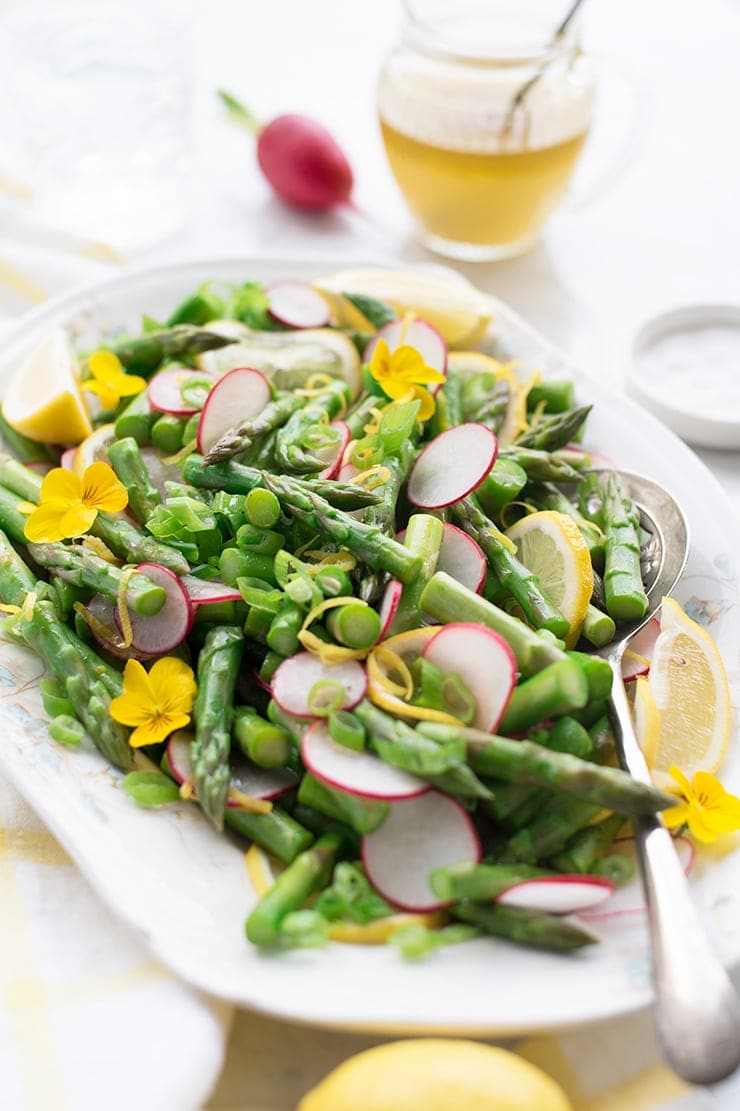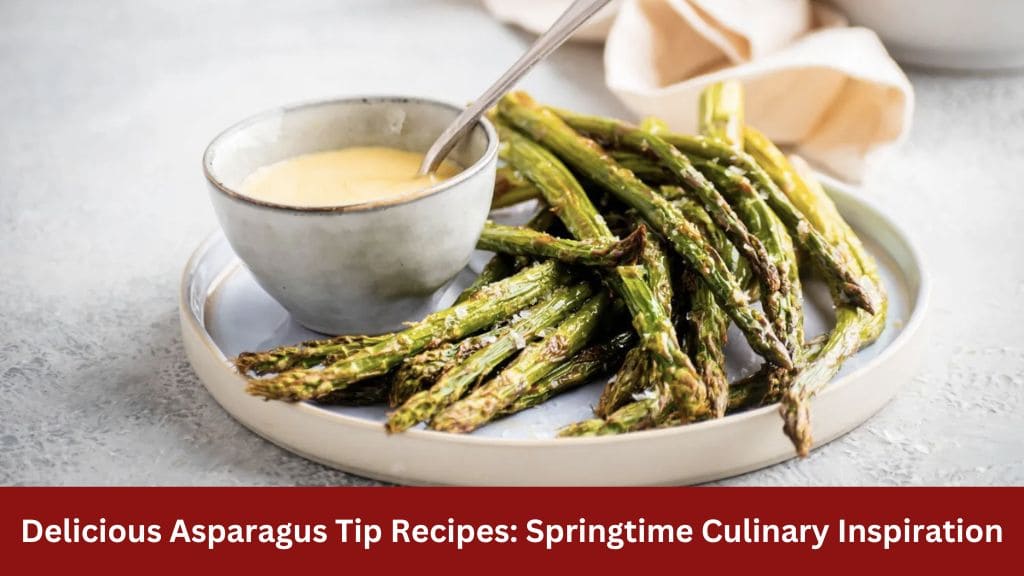Asparagus, often regarded as a springtime delicacy, offers a burst of flavor and nutrition with its tender, succulent tips. Whether you’re a seasoned chef or a home cook, there’s a world of culinary possibilities that asparagus tips bring to the table. In this blog post, we’ll explore various asparagus tip recipes, offering a blend of simple and gourmet options to suit any palate. From roasting and grilling to incorporating them into salads and main dishes, let’s dive into the delightful world of asparagus tips.
Health Benefits of Asparagus

Before we jump into the recipes, it’s worth noting the health benefits of asparagus:
- Rich in Nutrients: Asparagus is packed with vitamins A, C, E, K, and B6, along with folate, iron, copper, calcium, protein, and fiber.
- Antioxidant Properties: High in antioxidants, asparagus helps fight free radicals and reduce inflammation.
- Supports Digestive Health: Asparagus is a good source of dietary fiber, aiding in digestion and maintaining a healthy gut.
- Diuretic Properties: Its high levels of the amino acid asparagine make asparagus a natural diuretic, which can help flush excess fluid and salt from the body.
Now that we’ve established why asparagus is a fantastic addition to your diet, let’s get cooking!
Basic Preparation

How to Select and Store Asparagus
Selecting Asparagus: Look for firm, bright green spears with closed, compact tips. Thicker stalks are generally more tender, contrary to common belief.
Storing Asparagus: To keep asparagus fresh, place the stalks upright in a glass or jar with about an inch of water, cover loosely with a plastic bag, and store in the refrigerator. This method keeps them fresh for up to a week.
Prepping Asparagus Tips
- Washing: Rinse asparagus under cold water to remove any grit or sand.
- Trimming: Snap off the woody ends by bending the stalks; they will naturally break at the right spot. Alternatively, cut off the tough ends with a knife.
- Peeling: If the stalks are thick, consider peeling the lower part to ensure even cooking.
Simple Roasted Asparagus Tips
:max_bytes(150000):strip_icc()/Roasted-Asparagus-3018-0903413750b54e18be88432cad98083c.jpg)
Ingredients
- 1 bunch of asparagus tips: Aim for about a pound of asparagus. The tips are the most tender part of the stalks, but you can use the whole stalk if desired.
- 2 tablespoons olive oil: Olive oil helps to coat the asparagus evenly, ensuring they roast well without burning.
- Salt and pepper to taste: Simple seasoning allows the natural flavor of asparagus to shine. Adjust to your preference.
- Optional: Enhance your roasted asparagus with additional flavors such as lemon zest, Parmesan cheese, minced garlic, or fresh herbs like thyme or rosemary.
Instructions
- Preheat the Oven
- Preheat your oven to 425°F (220°C). A hot oven is crucial for roasting, as it helps to caramelize the outside of the asparagus while keeping the inside tender.
- Prepare the Asparagus
- Wash: Rinse the asparagus under cold water to remove any dirt or grit.
- Trim: Snap off the woody ends. Hold each asparagus spear near the base and bend it gently. It will naturally break at the point where the tender part meets the tougher end. This method ensures you only use the most tender parts of the asparagus.
- Dry: Pat the asparagus dry with a clean kitchen towel or paper towels. This step is important because any excess moisture can prevent the asparagus from roasting properly and cause it to steam instead.
- Season the Asparagus
- Toss with Olive Oil: Place the asparagus tips in a large mixing bowl or directly on the baking sheet. Drizzle with olive oil and toss to coat evenly. Using your hands ensures that each spear is well coated.
- Add Salt and Pepper: Sprinkle with salt and pepper to taste. For a simple yet flavorful twist, you can add a pinch of red pepper flakes or a dash of garlic powder.
- Arrange on a Baking Sheet
- Line with Parchment Paper: Line a large, rimmed baking sheet with parchment paper. This prevents sticking and makes for easy cleanup.
- Spread Evenly: Arrange the asparagus in a single layer on the baking sheet. Avoid overcrowding, as this can cause the asparagus to steam rather than roast.
- Roast in the Oven
- Cooking Time: Place the baking sheet in the preheated oven. Roast for 10-15 minutes, depending on the thickness of the asparagus. Thinner spears may only need 10 minutes, while thicker ones might require up to 15 minutes.
- Check for Doneness: The asparagus is done when it is tender and can be easily pierced with a fork. The tips should be slightly crispy and browned.
- Serve
- Optional Finishing Touches: Once out of the oven, you can add a squeeze of fresh lemon juice or zest, a sprinkle of grated Parmesan cheese, or a handful of chopped fresh herbs for an extra burst of flavor.
- Serving Suggestions: Serve the roasted asparagus immediately while it is hot and crispy. It makes a great side dish for grilled meats, fish, or as part of a larger vegetable platter.
Tips for Perfectly Roasted Asparagus
- Uniform Size: Try to use asparagus spears that are similar in size for even cooking. If you have a mix of thick and thin spears, consider separating them onto different baking sheets or adjusting the cooking times accordingly.
- High Heat: Roasting at a high temperature is key to achieving a good caramelization without overcooking the asparagus.
- Don’t Overcrowd: Ensure that the asparagus has enough space on the baking sheet. Overcrowding can lead to steaming rather than roasting, resulting in a less desirable texture.
Variations and Serving Ideas
- Lemon and Parmesan: Add freshly grated Parmesan and lemon zest right before serving for a bright and tangy finish.
- Garlic and Herbs: Toss the asparagus with minced garlic and chopped fresh herbs like thyme or rosemary before roasting.
- Balsamic Glaze: Drizzle a bit of balsamic reduction over the roasted asparagus for a sweet and tangy twist.
Grilled Asparagus Tips
:max_bytes(150000):strip_icc()/SEA-simple-grilled-asparagus-recipe-hero-02-withservingutensil-cd400626b79b49e280f07c8eaee52103.jpg)
Ingredients
- 1 bunch of asparagus tips: Approximately one pound. While the tips are the most tender part, you can use the entire stalk for grilling.
- 2 tablespoons olive oil: Helps to coat the asparagus, preventing them from sticking to the grill and promoting even cooking.
- Salt and pepper to taste: Basic seasonings that enhance the asparagus’s natural flavor.
- 1 lemon, halved: Adds a fresh, citrusy finish that complements the smoky flavor from the grill.
Instructions
- Preheat the Grill
- Medium-High Heat: Preheat your grill to medium-high heat, around 400-450°F (200-230°C). This temperature ensures a good char without overcooking the asparagus.
- Prepare the Asparagus
- Wash and Trim: Rinse the asparagus under cold water to remove any dirt. Snap off the woody ends by bending the stalk near the base; it will naturally break at the right point. Pat the asparagus dry with a clean towel to remove excess moisture.
- Optional Peeling: For thicker stalks, consider peeling the lower part to ensure even cooking.
- Season the Asparagus
- Toss with Olive Oil: In a large bowl, drizzle the asparagus tips with olive oil. Toss to coat evenly, ensuring every spear is covered.
- Add Salt and Pepper: Sprinkle with salt and pepper to taste. You can also add other seasonings such as garlic powder, paprika, or red pepper flakes for extra flavor.
- Grill the Asparagus
- Arrange on the Grill: Place the asparagus directly on the grill grates, perpendicular to the bars to prevent them from falling through. For very thin spears, consider using a grilling basket.
- Grill Time: Grill the asparagus for about 3-5 minutes per side. The exact time will depend on the thickness of the stalks. Thinner spears will take less time, while thicker ones will need a bit longer. Turn the asparagus occasionally to ensure even grilling.
- Check for Doneness: The asparagus is done when it is tender and has developed nice grill marks. The tips should be slightly charred but not burnt.
- Finish with Lemon
- Lemon Juice: Once the asparagus is off the grill, squeeze fresh lemon juice over the top. The acidity of the lemon brightens the flavors and complements the smoky taste from the grill.
- Lemon Halves on the Grill: For an added touch, you can grill the lemon halves for a few minutes. This caramelizes the sugars and enhances the flavor.
Tips for Perfectly Grilled Asparagus
- Uniform Size: Choose asparagus spears that are similar in size for even cooking. If you have a mix of thick and thin spears, grill them separately or adjust the cooking times accordingly.
- Dry Before Grilling: Make sure the asparagus is dry before tossing it with oil. Excess moisture can cause the asparagus to steam rather than grill, affecting the texture.
- Avoid Overcrowding: Spread the asparagus out on the grill so each spear has contact with the grill grates. Overcrowding can lead to uneven cooking.
Variations and Serving Ideas
- Parmesan and Garlic: After grilling, sprinkle the asparagus with freshly grated Parmesan cheese and minced garlic for a savory finish.
- Balsamic Glaze: Drizzle a balsamic reduction over the grilled asparagus for a sweet and tangy contrast.
- Herb Infusion: Toss the asparagus with chopped fresh herbs like thyme, rosemary, or basil before grilling to infuse additional flavors.
- Prosciutto-Wrapped: For a gourmet touch, wrap the asparagus tips in thin slices of prosciutto before grilling. The prosciutto crisps up and adds a salty, savory element.
Serving Suggestions
Grilled asparagus tips are incredibly versatile and can be served in various ways:
- As a Side Dish: Perfect alongside grilled meats, fish, or poultry.
- In Salads: Chop the grilled asparagus and add it to salads for a smoky flavor.
- In Pasta: Toss with pasta, olive oil, and Parmesan for a quick and delicious meal.
- With Eggs: Serve alongside poached or fried eggs for a tasty brunch option.
- As a Topping: Use grilled asparagus as a topping for pizzas or flatbreads.
Asparagus Tip Salad with Lemon Vinaigrette

Ingredients
For the Salad:
- 1 bunch of asparagus tips, blanched: Aim for tender-crisp asparagus tips that retain their vibrant green color.
- 1 cup cherry tomatoes, halved: Use ripe cherry tomatoes for sweetness and color contrast.
- 1/4 cup red onion, thinly sliced: Adds a subtle bite and a pop of color to the salad.
- 1/4 cup feta cheese, crumbled: Provides a creamy and tangy element that balances the flavors.
- 2 tablespoons fresh dill, chopped: Imparts a fresh and herbaceous flavor to the salad.
For the Lemon Vinaigrette:
- 1/4 cup olive oil: Use high-quality extra virgin olive oil for the best flavor.
- 2 tablespoons fresh lemon juice: Adds bright acidity and freshness to the vinaigrette.
- 1 teaspoon Dijon mustard: Helps emulsify the vinaigrette and adds a hint of tanginess.
- Salt and pepper to taste: Season to enhance the flavors of the salad.
Instructions
- Blanch the Asparagus
- Boil Water: Bring a large pot of salted water to a boil.
- Blanch Asparagus: Add the asparagus tips to the boiling water and cook for 2-3 minutes, or until they are bright green and tender-crisp.
- Ice Bath: Immediately transfer the blanched asparagus to an ice water bath to stop the cooking process and preserve their vibrant color. Drain well before using in the salad.
- Prepare the Salad
- Combine Ingredients: In a large bowl, combine the blanched asparagus tips, halved cherry tomatoes, thinly sliced red onion, crumbled feta cheese, and chopped fresh dill.
- Toss Gently: Toss the salad ingredients together gently to distribute the flavors evenly.
- Make the Lemon Vinaigrette
- Whisk Ingredients: In a small bowl, whisk together the olive oil, fresh lemon juice, Dijon mustard, salt, and pepper until well combined.
- Adjust Seasoning: Taste the vinaigrette and adjust the seasoning according to your preference. You can add more lemon juice for extra acidity or adjust the salt and pepper as needed.
- Dress the Salad
- Pour Vinaigrette: Drizzle the lemon vinaigrette over the salad, starting with a small amount and adding more as desired.
- Toss to Coat: Gently toss the salad until the ingredients are evenly coated with the vinaigrette. Be careful not to overdress the salad, as you want the flavors to shine through without being overwhelmed by the dressing.
- Serve
- Plate the Salad: Transfer the dressed salad to a serving platter or individual plates.
- Garnish: Optionally, garnish the salad with additional fresh dill or a sprinkle of feta cheese for an extra burst of flavor and visual appeal.
- Serve Immediately: Serve the asparagus tip salad with lemon vinaigrette immediately, while it is fresh and vibrant.
Tips for Success
- Blanching Asparagus: Be careful not to overcook the asparagus during blanching, as you want them to remain tender-crisp and vibrant green.
- Ice Water Bath: Placing the blanched asparagus in an ice water bath stops the cooking process and helps them retain their color and texture.
- Adjusting the Vinaigrette: Taste the vinaigrette before adding it to the salad and adjust the seasoning as needed to achieve the perfect balance of acidity and flavor.
- Gentle Tossing: When tossing the salad, do so gently to avoid crushing the delicate ingredients and to ensure the vinaigrette coats everything evenly.
Variations and Serving Suggestions
- Add Protein: For a heartier salad, add grilled chicken, shrimp, or tofu for protein.
- Add Nuts: Toasted pine nuts, sliced almonds, or walnuts add crunch and depth of flavor to the salad.
- Add Grain: Serve the salad over cooked quinoa, farro, or couscous for a nutritious and satisfying meal.
- Add Avocado: Creamy avocado slices add richness and creaminess to the salad.
Creamy Asparagus Tip Soup

Ingredients
- 1 bunch of asparagus tips, chopped: Use tender asparagus tips for the best flavor and texture.
- 1 medium onion, diced: Adds sweetness and depth of flavor to the soup.
- 2 cloves garlic, minced: Enhances the savory aroma of the soup.
- 2 tablespoons olive oil: Used for sautéing the vegetables and adding richness to the soup.
- 4 cups vegetable broth: Provides the base for the soup and enhances the asparagus flavor.
- 1/2 cup heavy cream: Adds creaminess and richness to the soup.
- Salt and pepper to taste: Season to enhance the flavors of the soup.
- Optional: Fresh chives, for garnish.
Instructions
- Sauté Vegetables
- Heat Olive Oil: In a large pot or Dutch oven, heat olive oil over medium heat.
- Sauté Onion and Garlic: Add diced onion and minced garlic to the pot. Sauté until the onion is translucent and fragrant, about 5 minutes.
- Add Asparagus and Broth
- Add Asparagus Tips: Add the chopped asparagus tips to the pot. Stir to combine with the onion and garlic.
- Pour in Broth: Add vegetable broth to the pot, covering the asparagus tips. Bring the mixture to a boil.
- Simmer SoupReduce Heat: Once the soup reaches a boil, reduce the heat to low. Cover the pot and let the soup simmer for about 10-15 minutes, or until the asparagus tips are tender.
- Blend Soup
- Use Immersion Blender: Use an immersion blender to blend the soup until smooth and creamy. Alternatively, carefully transfer the soup to a blender and blend in batches until smooth.
- Adjust Consistency: If the soup is too thick, you can add more vegetable broth or water to reach your desired consistency.
- Add CreamPour in Heavy Cream: Stir in the heavy cream until well combined. The cream adds richness and creaminess to the soup.
- Season and Serve
- Season with Salt and Pepper: Taste the soup and season with salt and pepper according to your preference.
- Garnish: Optionally, garnish the soup with chopped fresh chives for a pop of color and flavor.
- Serve: Ladle the creamy asparagus tip soup into bowls and serve hot.
Tips for Success
- Choose Tender Asparagus: Select fresh, tender asparagus tips for the best flavor and texture in the soup.
- Blend Smooth: Blend the soup until it is completely smooth and creamy for a luxurious texture.
- Adjust Consistency: If the soup is too thick, thin it out with more broth or water until you reach the desired consistency.
- Season to Taste: Taste the soup and adjust the seasoning with salt and pepper to enhance the flavors.
Variations and Serving Ideas
- Add Potato: For a thicker soup, add diced potatoes along with the asparagus tips. Cook until the potatoes are tender before blending.
- Add Herbs: Enhance the flavor of the soup with fresh herbs such as thyme, rosemary, or parsley.
- Add Lemon Zest: Add a sprinkle of fresh lemon zest to brighten the flavors of the soup.
- Add Croutons: Serve the soup with homemade or store-bought croutons for added texture and crunch.
Asparagus Tip and Mushroom Risotto
:max_bytes(150000):strip_icc()/mushroom-asparagus-risotto-HERO-8c06df4c1bfc4b0ebe57c90a752ccb20.jpg)
Ingredients
- 1 bunch of asparagus tips, chopped: Choose fresh asparagus tips for the best flavor and texture.
- 1 cup Arborio rice: Arborio rice is the traditional rice used for risotto, known for its creamy texture when cooked.
- 8 ounces mushrooms, sliced: Use your favorite mushrooms such as cremini, button, or shiitake for depth of flavor.
- 1 small onion, finely chopped: Adds sweetness and flavor to the risotto base.
- 2 cloves garlic, minced: Enhances the savory aroma of the dish.
- 4 cups vegetable broth, warmed: Provides the liquid base for cooking the risotto.
- 1/2 cup dry white wine: Adds acidity and depth of flavor to the risotto.
- 1/2 cup grated Parmesan cheese: Adds richness and umami flavor to the risotto.
- 2 tablespoons butter: Adds creaminess and richness to the dish.
- 2 tablespoons olive oil: Used for sautéing the vegetables and rice.
- Salt and pepper to taste: Season to enhance the flavors of the risotto.
Instructions
- Sauté Vegetables
- Heat Olive Oil: In a large skillet or Dutch oven, heat olive oil over medium heat.
- Sauté Onion and Garlic: Add finely chopped onion and minced garlic to the skillet. Sauté until the onion is translucent and fragrant, about 5 minutes.
- Add Mushrooms and Asparagus: Add the sliced mushrooms and chopped asparagus tips to the skillet. Sauté until the vegetables are tender and lightly browned, about 5-7 minutes. Remove the vegetables from the skillet and set aside.
- Toast RiceHeat Olive Oil: In the same skillet, add more olive oil if needed. Add Arborio rice to the skillet and toast, stirring constantly, until the rice grains are lightly golden and fragrant, about 2-3 minutes.
- Deglaze with WineAdd Wine: Pour dry white wine into the skillet, stirring constantly, until the wine is absorbed by the rice.
- Cook Risotto
- Add Broth: Gradually add warm vegetable broth to the skillet, one ladleful at a time, stirring constantly and allowing each addition of broth to be absorbed before adding more. Continue this process until the rice is creamy and tender, but still slightly al dente, about 18-20 minutes.
- Stir in Vegetables: When the risotto is almost done, stir in the sautéed mushrooms and asparagus tips, allowing them to heat through.
- Season: Season the risotto with salt and pepper to taste, adjusting the seasoning as needed.
- Finish with Butter and CheeseAdd Butter and Parmesan: Remove the risotto from heat and stir in butter and grated Parmesan cheese until melted and creamy. The butter adds richness and the Parmesan cheese adds depth of flavor and creaminess to the risotto.
- Serve
- Garnish: Optionally, garnish the risotto with additional grated Parmesan cheese and chopped fresh herbs such as parsley or chives.
- Serve Immediately: Serve the asparagus tip and mushroom risotto hot, in individual bowls, and enjoy the creamy, flavorful goodness.
Tips for Success
- Use Arborio Rice: Arborio rice is essential for achieving the creamy texture of risotto. Its high starch content creates the desired creaminess as it cooks.
- Gradually Add Broth: Adding the broth gradually allows the rice to release its starches slowly, resulting in a creamy texture.
- Constant Stirring: Stirring the risotto constantly helps release the rice’s starches, creating the creamy consistency characteristic of risotto.
- Taste and Adjust Seasoning: Taste the risotto as it cooks and adjust the seasoning with salt and pepper to your preference.
Variations and Serving Ideas
- Add Protein: For a heartier dish, add cooked chicken, shrimp, or sausage to the risotto.
- Add Herbs: Enhance the flavor of the risotto with fresh herbs such as thyme, rosemary, or sage.
- Add Lemon Zest: Add a sprinkle of fresh lemon zest to brighten the flavors of the risotto.
- Add Cream: For an even creamier texture, stir in a splash of heavy cream or half-and-half at the end of cooking.
Asparagus Tip Pasta with Lemon and Parmesan

Ingredients
- 1 bunch of asparagus tips, chopped: Select fresh asparagus tips for the best flavor and texture.
- 8 ounces pasta: Choose your favorite pasta shape such as spaghetti, fettuccine, or penne.
- 2 tablespoons olive oil: Used for sautéing the asparagus tips and flavoring the pasta.
- 2 cloves garlic, minced: Adds savory depth of flavor to the dish.
- Zest of 1 lemon: Adds bright citrusy notes that complement the asparagus and Parmesan.
- 1/4 cup grated Parmesan cheese: Adds nutty richness and umami flavor to the pasta.
- Salt and pepper to taste: Season to enhance the flavors of the dish.
- Optional: Fresh parsley or basil, for garnish.
Instructions
- Cook Pasta
- Boil Water: Bring a large pot of salted water to a boil.
- Cook Pasta: Add the pasta to the boiling water and cook according to package instructions until al dente. Reserve about 1/2 cup of pasta cooking water before draining.
- Sauté Asparagus Tips
- Heat Olive Oil: In a large skillet, heat olive oil over medium heat.
- Sauté Garlic: Add minced garlic to the skillet and sauté until fragrant, about 1 minute.
- Add Asparagus Tips: Add the chopped asparagus tips to the skillet and sauté until tender-crisp, about 5-7 minutes. Season with salt and pepper to taste.
- Combine Pasta and Asparagus
- Add Cooked Pasta: Add the cooked and drained pasta to the skillet with the asparagus tips.
- Add Lemon Zest: Sprinkle lemon zest over the pasta and toss to combine, ensuring the pasta and asparagus are evenly coated with the lemon zest.
- Add Parmesan Cheese
- Sprinkle Parmesan: Sprinkle grated Parmesan cheese over the pasta and toss again to combine. The heat from the pasta will melt the cheese slightly and create a creamy sauce.
- Adjust Consistency: If the pasta seems dry, you can add some of the reserved pasta cooking water, a little at a time, until the desired consistency is reached.
- Serve
- Garnish: Optionally, garnish the pasta with fresh parsley or basil for a pop of color and freshness.
- Serve Immediately: Serve the asparagus tip pasta with lemon and Parmesan hot, in individual bowls, and enjoy the fresh and vibrant flavors.
Tips for Success
- Cook Pasta Al Dente: Be sure to cook the pasta just until al dente, as it will continue to cook slightly when combined with the other ingredients.
- Don’t Overcook Asparagus: Sauté the asparagus tips just until they are tender-crisp to preserve their vibrant color and texture.
- Use Fresh Lemon Zest: Freshly grated lemon zest provides the best flavor and aroma. Avoid using bottled lemon juice as it lacks the freshness of zest.
- Toss Well: Be sure to toss the pasta and asparagus thoroughly to ensure that every bite is evenly coated with the lemon and Parmesan flavors.
Variations and Serving Ideas
- Add Protein: For a heartier dish, add cooked chicken, shrimp, or tofu to the pasta.
- Add Cherry Tomatoes: Halved cherry tomatoes add sweetness and freshness to the dish.
- Add Red Pepper Flakes: For a touch of heat, sprinkle red pepper flakes over the pasta before serving.
- Add Toasted Pine Nuts: Toasted pine nuts add crunch and nuttiness to the pasta.
Asparagus Tip Frittata

Ingredients
- 1 bunch of asparagus tips, chopped: Select fresh asparagus tips for the best flavor and texture.
- 6 large eggs: Use fresh, high-quality eggs for the best results.
- 1/4 cup milk or cream: Adds richness and creaminess to the frittata.
- 1/2 cup grated cheese: Choose your favorite cheese such as cheddar, mozzarella, or feta for added flavor.
- 2 tablespoons olive oil or butter: Used for sautéing the asparagus tips and preventing sticking in the skillet.
- Salt and pepper to taste: Season to enhance the flavors of the frittata.
Instructions
- Preheat OvenPreheat your oven to 350°F (175°C) to prepare for baking the frittata.
- Sauté Asparagus Tips
- Heat Oil: In a large oven-safe skillet, heat olive oil or butter over medium heat.
- Sauté Asparagus: Add the chopped asparagus tips to the skillet and sauté until tender-crisp, about 5-7 minutes. Season with salt and pepper to taste.
- Prepare Egg MixtureWhisk Eggs: In a mixing bowl, whisk together the eggs, milk or cream, grated cheese, salt, and pepper until well combined. The cheese adds richness and flavor to the frittata.
- Cook Frittata
- Add Egg Mixture: Pour the egg mixture over the sautéed asparagus tips in the skillet. Stir gently to distribute the ingredients evenly.
- Cook on Stovetop: Cook the frittata on the stovetop over medium heat for 3-4 minutes, or until the edges begin to set.
- Bake FrittataTransfer to Oven: Transfer the skillet to the preheated oven and bake for 12-15 minutes, or until the frittata is set in the center and lightly golden on top. The eggs should be cooked through and no longer runny.
- Serve
- Cool and Slice: Allow the frittata to cool for a few minutes before slicing it into wedges.
- Garnish: Optionally, garnish the frittata with fresh herbs such as parsley or chives for a pop of color and freshness.
- Serve Warm: Serve the asparagus tip frittata warm, either as a main dish or as part of a brunch spread.
Tips for Success
- Don’t Overcook Asparagus: Be careful not to overcook the asparagus tips during sautéing, as they should be tender-crisp and retain their vibrant color.
- Use an Oven-Safe Skillet: Make sure to use an oven-safe skillet for cooking and baking the frittata to avoid transferring the mixture to a different dish.
- Customize Ingredients: Feel free to customize the frittata with additional ingredients such as cooked bacon, diced bell peppers, or sliced mushrooms for added flavor and texture.
Variations and Serving Ideas
- Add Herbs: Enhance the flavor of the frittata with fresh herbs such as thyme, basil, or dill.
- Add Sundried Tomatoes: Diced sundried tomatoes add a sweet and tangy flavor to the frittata.
- Add Garlic: Sauté minced garlic with the asparagus tips for an extra savory kick.
- Add Potatoes: Cooked and diced potatoes add heartiness and substance to the frittata.
Conclusion
Asparagus tips are a versatile and delicious ingredient that can elevate a wide range of dishes. Whether you prefer them simply roasted, tossed in a salad, or incorporated into more elaborate recipes like risotto and frittata, there’s no shortage of ways to enjoy this springtime favorite. With these recipes, you can make the most of asparagus season and delight your taste buds with fresh, vibrant flavors.
Happy cooking! Please share your asparagus tip creations and let us know your favorite recipes in the comments below. Bon appétit!





